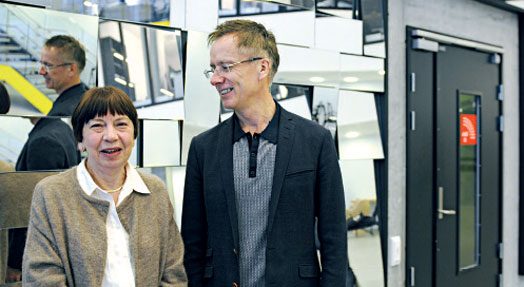Stressed by technology
The consequence of constantly being available is susceptibility to stress from work around the clock. "Technology makes it easier to disturb people. Managers must take this into consideration," according to Anna Mette Fuglseth and Øystein Sørebø.
14.01.2015 - Astri Kamsvåg
"It's a dilemma that something originally meant to help make daily life more efficient can be experienced as an extra burden by many," says Fuglseth.
Anna Mette Fuglseth is a Professor in the Department of Strategy and Management at the Norwegian School of Economics (NHH). Together with Sørebø, who is a Professor in the Institute for Strategy and Economics at the Buskerud and Vestfold University College, she carries out research on technostress.
Together, they published the article "The effects of technostress within the context of employee use of ICT". Now, they are working on yet another article on the topic.
"Feels like an invasion"
Both at work and otherwise in daily life, we are increasingly available. Many expect answers to enquiries almost immediately, and the smart phone has become a permanent companion for many people. For many people, constant availability leads to increasing stress.
"You feel a certain mental strain. We use tablets, mobile phones and PCs when we are at work. E-mails and other enquiries arrive constantly. It is experienced as limitless, and can be perceived as an invasion of privacy when you are home and should be relaxing," says Sørebø.
According to the professors, many also experience stress in relation to new software, or hardware and software that does not function as desired. You are prevented from doing your work when your equipment is not working as it should.
"Employees easily feel that there is pressure from the environment that exceeds their expertise," notes Fuglseth.
"It may be that you yourself should have better updated your skills related to the technology. If you do not have a sense of mastery, you may become uncertain of your own job security. Some people think they lose to competition because they are not able to keep up with the technology," she says.
Profitable investment
Fuglseth and Sørebø believe that management must pay special attention to the consequences that new technology may have on employees. They hope the research can help managers cope with the negative effects of stress.
"Many managers are probably not sufficiently focused on the fact employees actually can be stressed. For each kroner invested in training, two kroner are saved in terms of stress and inefficient use. It is money well invested, with good returns," notes Sørebø
"When it is fun to use the technology, stress disappears."
A number of measures can be taken to counteract the negative effects of technology in the workplace. The two researchers point especially to competency and user support as important.
"Our investigations show that traditional measures such as good user support are an effective means to mitigate technostress among employees," says Fuglseth.
She believes managers should motivate employees to use IT, and perhaps reward those who adopt IT tools in an efficient manner.
"They must also create an environment in which it is interesting and useful to get to know the new tools."
Managers ought to provide employees with clear signals about expectations for technology use, particularly for use and availability outside working hours and the workplace, and not least, in connection with holidays. Clear guidelines may be important stress preventive measures, according to the researchers.
Tools
Through their work, the professors have developed an instrument to identify various forms of technostress. In this way they hope to be able to help managers implement the right measures.
"It is important to identify how technology leads to stress among employees," says Sørebø.
The instrument is a questionnaire that identifies technostress over several categories such as uncertainty, complexity, invasion and strain.
Together, the parameters form an overall picture of the stress burden in the organisation.
"Technology should be a tool that supports what you are working with, so that you can use time on problem solving. Technology should not be a bothersome factor that prevents you from doing what you do," emphasises Fuglseth.
Facts
Technostress deals with failure in an employee's ability to adapt to use of technology at work in a healthy way. A number of factors may contribute to the failure of this capability, including that employees find that:
- they are pressured to work both faster and more
- they must be available to others at work, at leisure and during holidays
- it is difficult to master the technology, including due to the complexity and continual changes
- technology becomes a threat to their job, because other, more proficient staff takes over
- changes continually occur, pressing forward in terms of new technologies and changes to software
"The effects of technostress within the context of employee use of ICT" is published in Computers in Human BehaviorVolume 40, November 2014.
This article was published in Norwegian in NHH Bulletin no 4/2014.

Anna Mette Fuglseth is a Professor in the Department of Strategy and Management at NHH. Together with Øystein Sørebø, who is a Professor in the Institute for Strategy and Economics at the Buskerud and Vestfold University College, she carries out research on technostress.
Foto: Torill Sommerfelt Ervik
|

